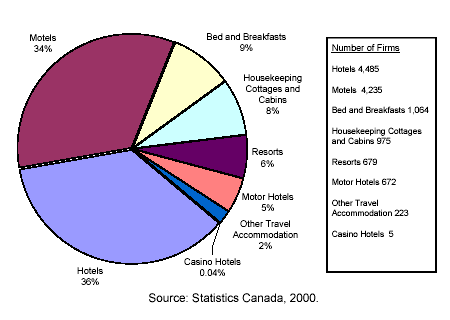
E-commerce Overview Series:
Tourism Accommodation Sector in Canada
Publication Date: February 2004
View and print this document in PDF format.
To read the PDF version, you need Adobe Acrobat Reader on your system.
Description of the Sector
The accommodation sector is at the centre of Canada's tourism industry. It includes a large number of small- and medium-sized enterprises (SMEs) operating several types of establishments: hotels, motels, bed and breakfasts, housekeeping cottages and cabins, resorts, motor hotels, casino hotels and other forms of lodging. Note the strong presence of hotels and motels as illustrated in Diagram 1. These tourism businesses are primarily located in four provinces, namely, Ontario, Quebec, British Columbia and Alberta.
Diagram 1
Tourism Accommodation by Type of Establishment
 d d
Role of Information and Communication Technologies (ICT) in the Sector
Generally speaking, consumers use tourism industry Web sites to obtain road maps (59%), accommodation (54%), activity programming (46%), air fares (45%), restaurants and entertainment (36%) and calendars of local events (26%) (Scott's Business Directory, 2002). Of all of the industrial sectors, the tourism industry has known the greatest success in terms of electronic business (e-business) adoption. Online spending on travel by Canadians has posted strong gains and is expected to increase from $1.50 to $11 per person in the coming five years. This suggests that online activity is going to accelerate considerably over the next two years (International Data Corporation, July 2002).
Historically, the structure of the tourism industry meant that businesses in the accommodation sector lacked direct access to travellers and consumers. E-business has changed the way firms in this sector can do business. In fact, groups in the hotel sector are developing communications networks designed to compete with Global Destination Systems (GDS). These GDS are important technology solutions for information management and are used primarily by travel agencies and airlines. To cope with this new competition, the GDS have become suppliers of technology solutions directed at accommodation SMEs wishing to set up reservation centrals. In Canada, American players dominate the GDS market. There are four large reservation centrals: Wordspan, Sabre, Galileo and Amadeus. Most sites such as Expedia and E-Travel target leisure and business travellers.
It has been confirmed that there is little difference in the rate of e-business adoption among small and large hotel operators in industrialized countries (Travel Industry Association of America, 2001). Some 51% of small establishments have an e-business strategy compared with 69% of large establishments; globally, 58% of establishments as a whole have an e-business strategy. This suggests that in the accommodation sector, unlike many others, differences among large and small firms are of little consequence in terms of their strategic intent concerning e-business.
The main product of accommodation networks is the package tour. The production in real-time of personalized package tours is the principal change foreseeable in the coming years. This change will have some potential impacts, as the ICT will make it possible to develop tailor-made and personalized package tours for buyers by combining a much wider range of products and services than in the past, and to increase the value of package tours by coordinating them with events scheduled in a specific city or destination.
Airlines and tourism attractions are the two main competitors in the sector for online reservations for accommodation.
New Electronic Business Models
The key e-business models in the accommodation sector are third party or electronic marketplaces, virtual or electronic shops and virtual shopping centres or e-malls. The latter are initiatives launched by geographic and sectoral groups. Diagram 2 sets out a few examples of firms or Web sites thriving in the tourism accommodation sector. In Canada, SMEs in the sector are found mainly in quadrants two and four.
Distribution portals play a key role in the accommodation sector, especially marketplaces from outside of the industry, such as Bonjour Québec! or Expedia (an American initiative). In the accommodation sector, these portals impose business and technology standards, and control reservations in the accommodation network.
Diagram 2
Technology Solutions Arising From Business Models
 d d
To fully understand diagram 2, the reader should consult the document entitled "Electronic Business Models: A Conceptual Framework for Small- and Medium-sized Canadian Enterprises" at the following address: www.cefrio.qc.ca/english/pdf/Strategis%20_Eng.pdf. This document describes in detail the four main models illustrated in the above diagram.
Examples of Web Sites Taken From Canada's Tourism Accommodation Sector
E-shop
E-malls
Third Party Marketplaces
Issues for Canadian Firms
Whereas independent Web sites generate little consumer traffic, access to distribution channels becomes an important consideration. Regional destination management portals can play a key role in ensuring the survival of SMEs on the Internet.
Barriers
Travellers are reluctant to make their reservations online, and continue to use agents as trustees, or to validate decisions related to a trip or stay. Despite the advancement of virtual agencies, consumers limit their use to an information function.
Opportunities Open to Firms in the Sector
Business travel represents an attractive niche opportunity that provides some promising prospects. ICT offers firms in the accommodation sector the chance to craft personalized package tours. These package tours could combine a much wider range of products and/or services than ever before (cars, cruises, et cetera).
References
Statistics Canada, 2000
Scott's Business Directory, 2002
International Data Corporation, July 2002
Travel Industry Association of America, 2001
http://strategis.gc.ca
To learn more, you can visit these Web sites:
www.cefrio.qc.ca/english/indexAccueil.cfm
http://strategis.gc.ca/tourism
http://strategis.gc.ca/ebizenable
http://sourcecan.com
www.canadatourism.com
Published in Partnership
This document has been prepared by CEFRIO, as part of the project "New E-business Models and SME Development", a project undertaken in cooperation with Industry Canada, the National Bank of Canada, TELUS, CANARIE and Canadian Heritage.
The research team included Mrs. Louise Côté and Mr. Michel Vézina from HEC Montréal, and Mr. Vincent Sabourin from the Université du Québec à Montréal.
For more information, please go to the CEFRIO Web site - the authority on information technology appropriation - at: www.cefrio.qc.ca/english/indexAccueil.cfm.
|